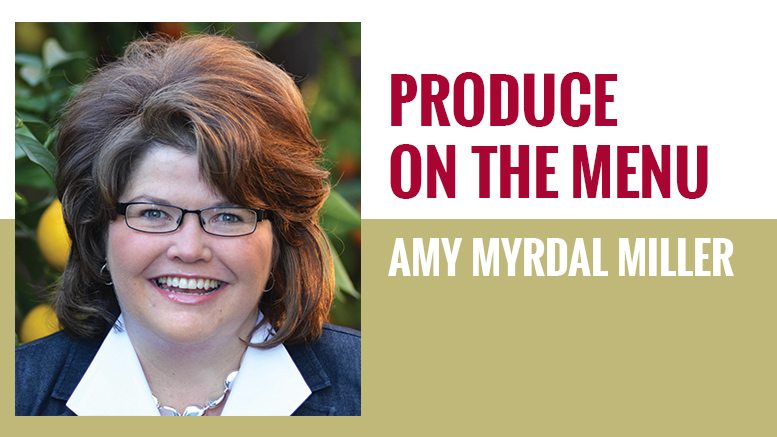Where Do Great Flavors Come From?
September 2, 2018 | 4 min to read
Delivering great flavor in produce involves many challenges, from breeding that prioritizes agronomic benefits over taste, to growing conditions influenced by weather and pests. Factors such as harvest timing, storage, and the treatment of produce in restaurants critically impact flavor. Amy Myrdal Miller emphasizes the need for culinary training focused on produce and innovative flavor pairing strategies, noting that enhancing flavor is crucial for increasing consumption. Everyone, from growers to chefs, plays a vital role in this endeavor.

Originally printed in the September 2018 issue of Produce Business.
 If there’s a food category that has more challenges than produce when it comes to delivering great taste to the consumer, I’d like to hear your thoughts on what it is. There are so many factors that affect the flavor in a bite of produce.
If there’s a food category that has more challenges than produce when it comes to delivering great taste to the consumer, I’d like to hear your thoughts on what it is. There are so many factors that affect the flavor in a bite of produce.
Breeding is the first factor that comes to mind. When breeding focuses on agronomic benefits, such as yield, that makes the farmer happy. When breeding focuses on flavor as well as agronomic benefits, that has the potential to make everyone happy. But when you start to factor in everything that can negatively influence flavor from field to plate, is all hope lost?
Growing conditions can have a major impact on the flavor of produce. Perfect seed or rootstock can only do so much. Then Mother Nature needs to lend a helping hand in terms of weather patterns during the growing season, pests and more.
Harvest is fraught with issues that can have a negative impact on flavor. Harvesting melons, for example, when the brix is too low reduces the sweetness and flavor intensity of the melon. A chef can use melon in a salad with a perfectly balanced vinaigrette to perk up dull flavors, but little can be done to improve the texture of an underripe melon.
Storing also can affect flavor. An apple off the tree in August will have a different flavor from an apple that’s been stored in atmosphere-controlled conditions for six to 12 months. And then there’s the issue of how produce is stored in a walk-in cooler.
Does Romaine lettuce enjoyed in a field during a tour taste better than chopped Romaine that’s been packaged in a bag for sale in retail? It definitely does. But again, a chef who makes a great Caesar dressing can make that crunchy, sweet Romaine play a leading role in an awesome entrée salad.
If the onions are stored near the stone fruit, will that peach deliver its full flavor potential?
 Processing and packaging can also have an impact on flavor. Does Romaine lettuce enjoyed in a field during a tour taste better than chopped Romaine that’s been packaged in a bag for sale in retail? It definitely does. But again, a chef who makes a great Caesar dressing can make that crunchy, sweet Romaine play a leading role in an awesome entrée salad.
Processing and packaging can also have an impact on flavor. Does Romaine lettuce enjoyed in a field during a tour taste better than chopped Romaine that’s been packaged in a bag for sale in retail? It definitely does. But again, a chef who makes a great Caesar dressing can make that crunchy, sweet Romaine play a leading role in an awesome entrée salad.
Shipping and handling are other important factors in flavor. If the grower-shipper-packer does everything well, and the distributor follows all procedures perfectly but then the produce upon delivery does not get stored properly at the operating unit/restaurant, the flavor can suffer.
Now we get to focus on factors in foodservice that can affect produce, including how much respect the kitchen team gives to produce. In a typical restaurant, the line cook or sous chef paid the most money cooks the protein … and the person paid the least prepares the produce. Many in culinary schools are paying attention to this issue and focusing more culinary training on preparing produce. But much more work needs to be done in this area.
And then there are all the flavor development strategies that can turn a humble produce item into the most memorable mouthful of a person’s life. Researchers in Spain have been studying the flavor networks of world cuisines to determine how flavor pairings impact flavor. For example, why do dishes made with walnuts taste better when lemon juice or zest is added? Why do beef and tomatoes pair so well together? And why do citrus and chocolate create such incredible flavor?
These same researchers also are looking at how certain ingredients can create flavor bridges by bringing together two ingredients that have no flavor molecules in common to create a powerful flavor synergy. An example of this is apricots and whiskey. Tomato can bridge the flavors of apricots and whiskey to create what the researchers call a “flavor chain.” While few home cooks are using flavor bridges to create memorable meals, chefs all over the world are exploring these principles and applying them to meals in high-end restaurants.
There is so much we can learn about enhancing flavor in produce. I applaud everyone out there — from the breeders and growers to distributors and chefs — who are doing this important work. If we’re going to make progress on increasing consumption, produce has to taste great.
Amy Myrdal Miller, MS, RDN, FAND is a farmer’s daughter from North Dakota, award-winning dietitian, culinary nutrition expert, and founder and president of Farmer’s Daughter Consulting, Inc. She is the director of The Culinary Institute of America Healthy Menus R&D Collaborative and a consultant for the Produce for Better Health Foundation. You can learn more about her business at www.farmersdaughterconsulting.com, and you can follow her insights on food and flavor on Twitter @AmyMyrdalMiller
3 of 24 article in Produce Business September 2018

